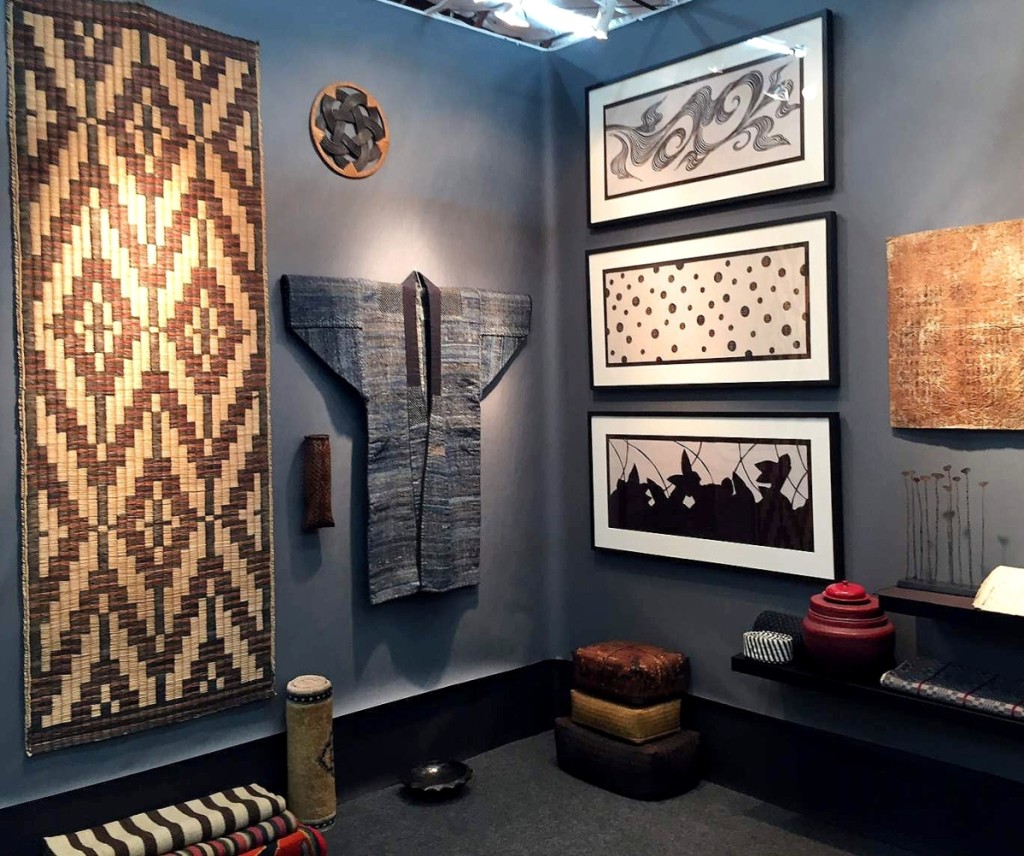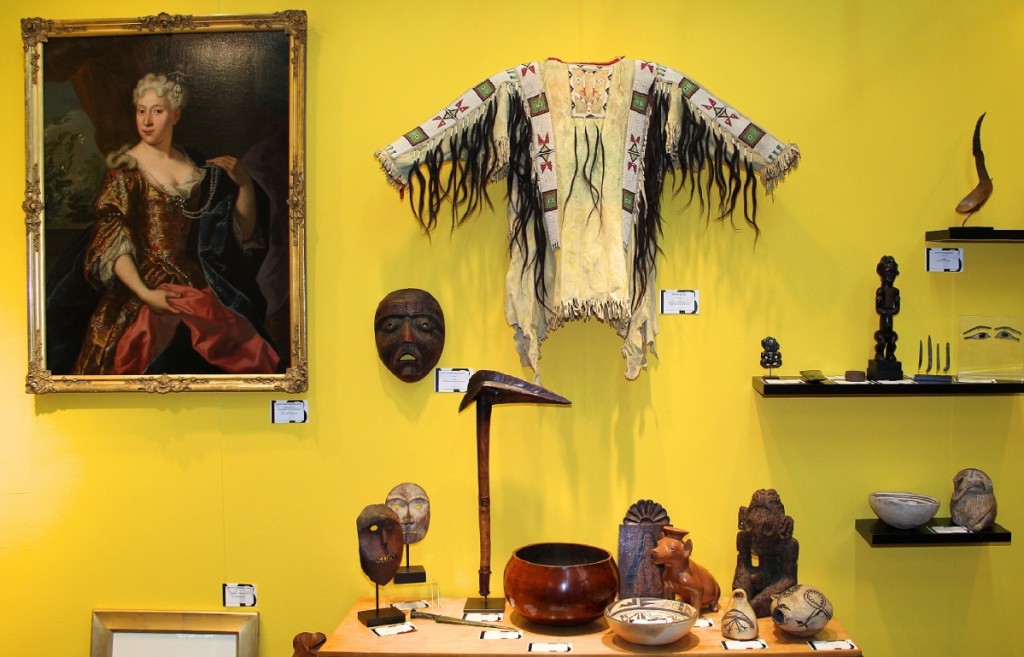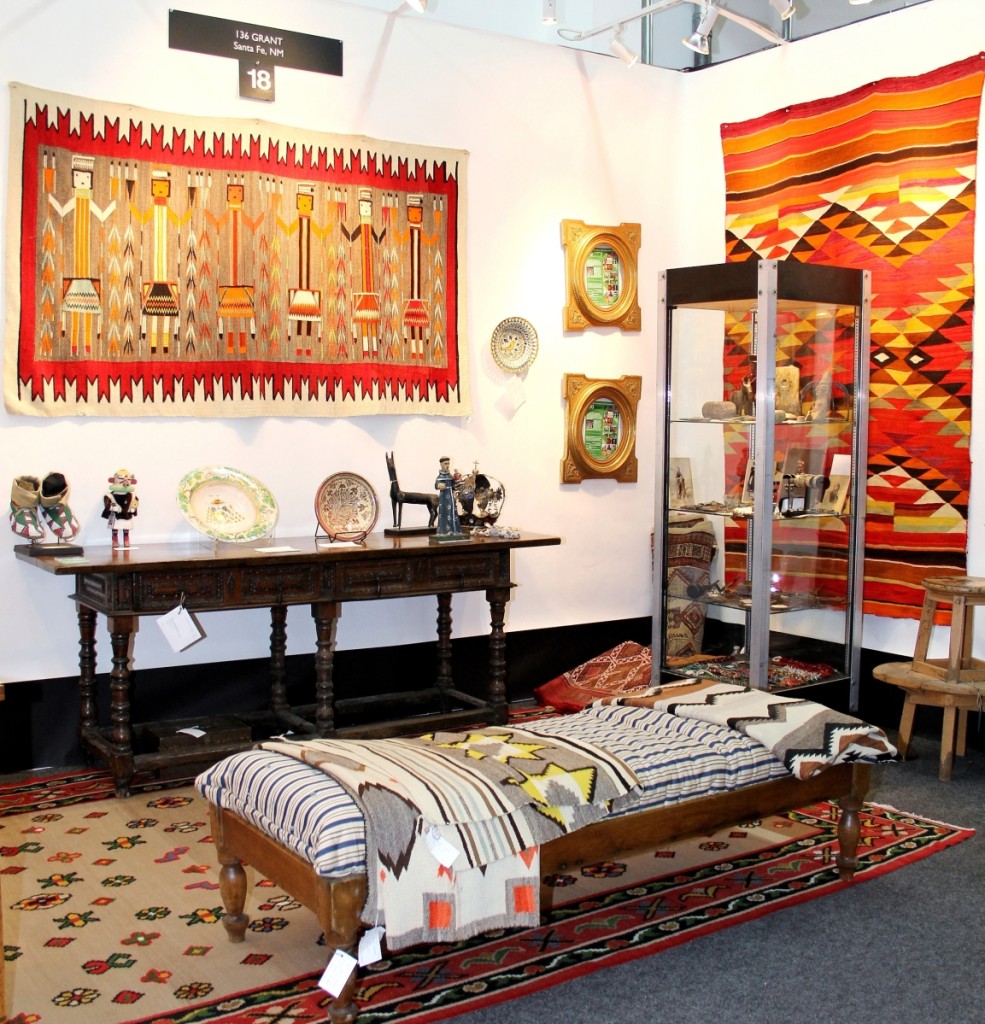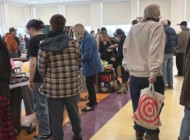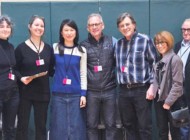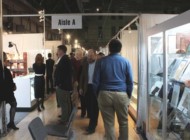Review and Photos by Laura Beach
SANTA FE, N.M. – “When we started this show, we wanted it to reflect the diversity that characterizes collecting today,” dealer and promoter Kim Martindale said of Objects of Art Santa Fe, the chic, colorful presentation that Martindale co-produces with fellow Californian John Morris. The fair at El Museo Cultural, a temporary exhibition space in the heart of Santa Fe’s Railyard District, drew 3,000 visitors between August 11 and 13, opening with a benefit preview for New Mexico PBS on August 10.
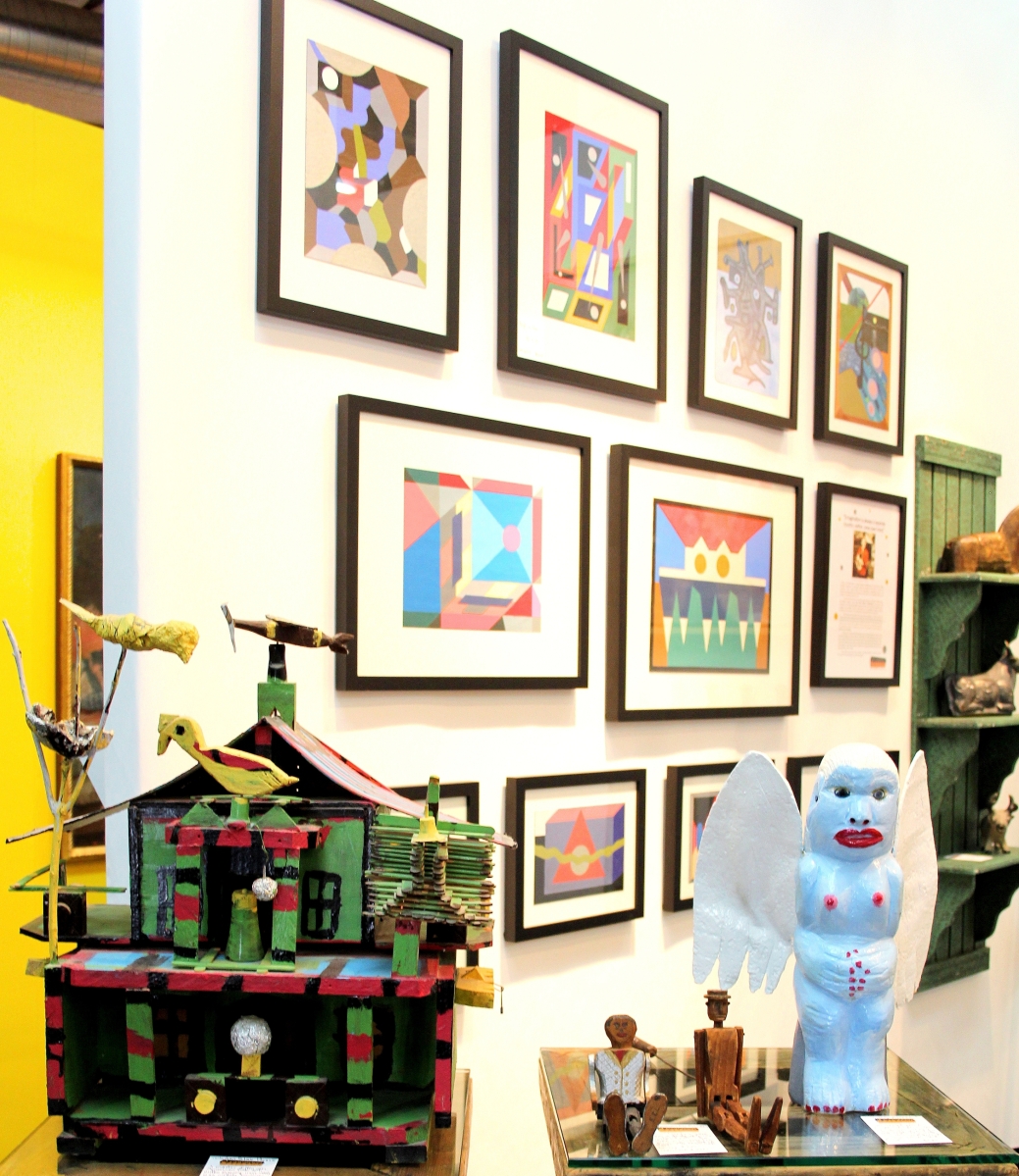
Folk sculpture by Willie Massey and Isaac Smith with paintings by Larry John Palsson. J. Compton Gallery, Wimberly, Texas.
Shared with another California dealer, Philip Garaway of Venice, and Albuquerque, N.M., dealer and artist Victoria Roberts, whose sculptural assemblages combine bits of found objects, Martindale’s gallery-style display combined fine and folk, antique and contemporary, Western and non-Western art. A small, salon-style enclosure juxtaposed limited-edition Picasso pottery in metallic glazes with a painting and prints by Guatemalan artists Arturo Monroy and Diego Isaias Hernandez Mendez. A large, adjoining space paired Olmec and Mayan sculpture with Guatemalan and Mexican masks and figures.
Objects of Art Santa Fe does away with cultural and temporal boundaries in an easy, relaxed way. At the same time, it is faithful to a distinctive Santa Fe aesthetic honed over the past century, an approach to the material past embracing global handicraft and traditional Hispano and Native American art.
Objects of Art Santa Fe is especially rich in textile art, a theme underscored by “Homage to the Square.” The special presentation organized by Mark Sublette Medicine Man Gallery of Tucson joined Navajo weaving in bold, geometric patterns and vibrant palettes with Modern paintings and prints by Josef Albers (1888-1976) and Jorge Fick (1932-2004). A 112-page color catalog published by Sublette accompanied the selling exhibit. Prices ranged from the low four figures to $85,000 for a Navajo Second Phase chief’s blanket of circa 1850-60.
Facing each other in the center of the show were John Ruddy, featuring antique Japanese textiles, garments and baskets, and Dancing Threads, Indonesian weaving specialists who offered an early Twentieth Century Sumatran woman’s sarong embroidered with metallic thread. Nearby, Casey Waller of Caravanserai, Ltd, dazzled with colorfully embroidered textile panels inspired by antique Caucasian and Ottoman examples, the product of a workshop project launched in Armenia in 2004.
Putting it all together were Lee, Vichai and Dhani Chinalai, New York dealers who have long handled Southeast Asian tribal antiques, primarily textiles and jewelry, and have more recently branched into contemporary expressions of the same. Lee Chinalai spoke enthusiastically of their participation in the International Folk Art Market, an annual not-for-profit event that brings 160 master artists from 53 countries to Santa Fe each July with the goal of preserving cultural traditions and creating self-sustaining communities. The Chinalais work closely with Somporn Intaraprayong (b 1959), honored at the International Folk Art Market this year and featured at Objects of Art, where the Chinalais arrayed garments and hangings sewn, woven and dyed in indigo by the Thai textile artist and her circle. By an unknown maker, a vintage piece in the Chinalais’ booth was a set of ceremonial clothing made of human hair. The rare Yi minority garment from Yunnan Province in South China dated from the early to mid-Twentieth Century.
Others in the wearable art category included Danielle Herbst of Atelier Danielle, a modern-day Fortuny who creates imaginative, festive ensembles in exotic, luxurious fabrics; Asiatica, the Kansas City-based maker of artisanal clothing in Japanese fabrics, vintage and contemporary; and Amy Kahn Russell of Ridgefield, Conn., a jewelry designer whose pieces combine antique Chinese and Tibetan fragments, fossils, semiprecious stones, and custom enamels and intaglio.
On a playful note, Arizona dealer and market maker Barry Friedman, author of Chasing Rainbows and Still Chasing Rainbows: Indian Trade and Camp Blankets, arrayed a colorful assortment of the throws he made popular with the help of merchandisers such as Ralph Lauren.
“Ward Lockwood (1894-1963) and John Marin (1870-1953) painted together for two years in Taos in the 1920s. You really see Marin’s influence here,” Robert Parsons said of a northern New Mexico landscape watercolor by Lockwood that hung near works by O.E. Berninghaus (1874-1952), Willard Nash (1898-1942), Fremont Ellis (1897-1985) and E.M. Hennings (1886-1956). Parsons, who handles classic and contemporary Taos School paintings, also featured midcentury abstractions by Barbara Latham (1896-1989), who met her husband Howard Cook (1901-1980) in Taos, where both studied with pioneering Modernist Andrew Dasburg (1887-1979).
More classics surfaced at Mark Sublette Medicine Man Gallery, where paintings by Joseph Henry Sharp (1859-1953), Nicolai Fechin (1881-1955), Leon Gaspard (1882-1964) and E.I. Couse (1866-1936) joined Hopi kachinas, Pueblo pottery and Navajo weaving.
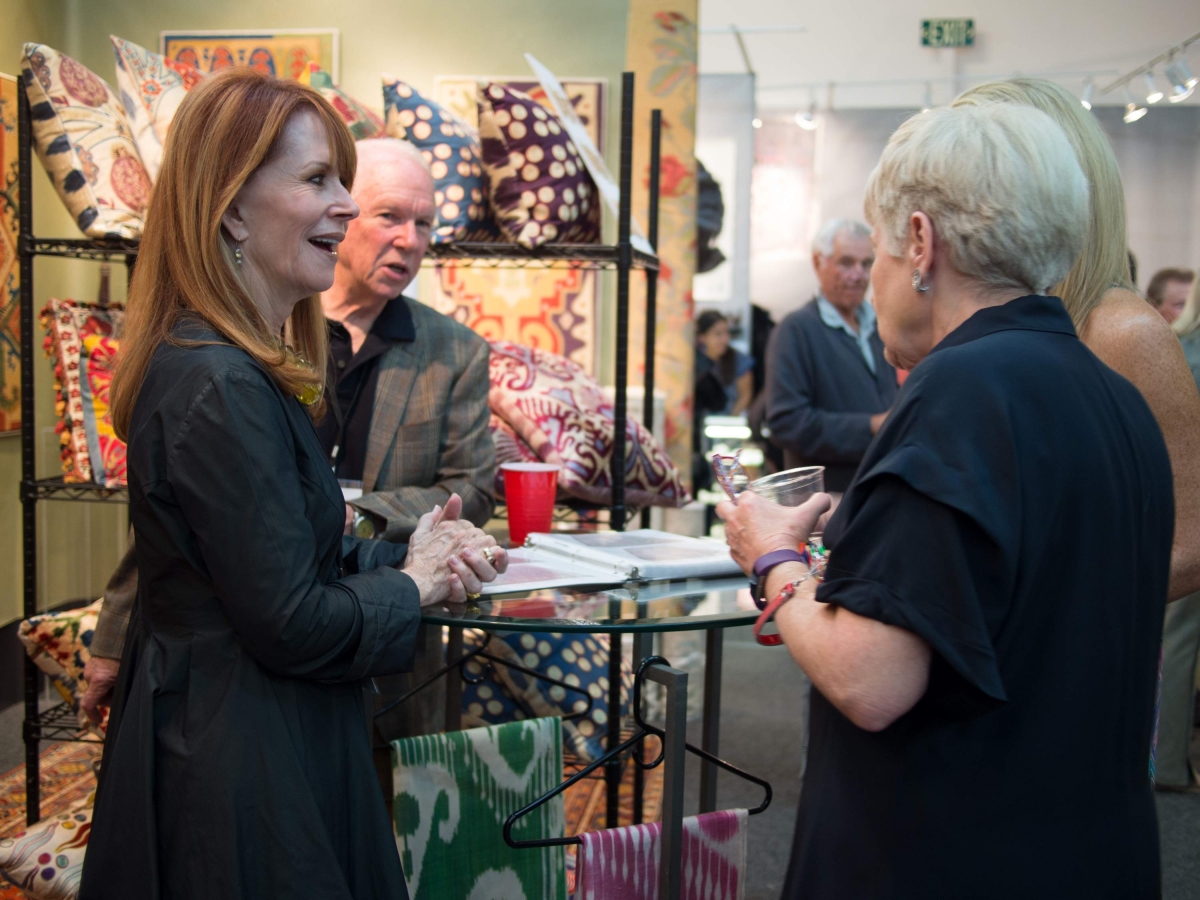
From left, Helen Thompson, author of Marfa Modern, and exhibitor Casey Waller of Caravanserai, Ltd, talk with showgoers in Waller’s booth. Photo courtesy Objects of Art.
Arizona dealer Jan Musial added texture to the fair with Navajo and Pueblo easel painting by Narciso Abeyta (1918-1998), Alfonso Roybal (Awa Tsireh) (1898-1955) and Gerald Nailor (1917-1952), pulling the display up to the present with a painting by Tony Abeyta (b 1965), who brings a contemporary sensibility to traditional New Mexican imagery.
Martindale and Morris welcomed S.M. Fine Art Gallery, which maintains showrooms in New York City and Seoul, and handles Modern and contemporary Korean, American and European art.
Sculpture enthusiasts found much to admire at Arnold Lieberman, who handles Hindu and Buddhist objects spanning two millennia, and at Taylor Dale Tribal Arts, offering African and Oceanic pieces.
“We’ve been showing paintings in our New York City gallery over the last few years,” said John Molloy, a longtime specialist in Native American art. Molloy’s high-octane presentation combined photographs by Irving Penn (1917-2009) and a painting by Kiki Smith (b 1954), represented in the 2017 Venice Biennale, with Inuit masks and Plains and Plateau beadwork. Sprightly oil stick paintings by James Havard (b 1937) from his “Color Talkers” and “Paint People” series lined Molloy’s outside wall. Havard, a longtime Santa Fe resident who now resides outside Philadelphia, is deeply influenced by tribal and Outsider art, Molloy said.
The participation of Diptych Fine Arts from Zapopan, near Guadalajara, raised the bar for Spanish Colonial art. The Mexican dealers showed Eighteenth and early Nineteenth Century Mexican painting, most of it religious in nature, with Eighteenth Century Bolivian church silver.
Calabaza of Glorieta, N.M., and James M. Jeter of Santa Barbara, Calif., highlighted the northern reaches of Spain’s empires with carved pine boxes and a nearly life-size carved and painted Christo.
Mexican pottery, lacquerware and ex-voto paintings on tin were for sale at Turkey Mountain Traders, which showed the material with framed prints by Leonard Baskin (1922-2000).
Holbrook Faircloth offered country Americana, hanging a pieced quilt and stocking cases, atop which sat a couple of wildfowl decoys, with colorful spongeware pottery.
J. Compton Gallery mingled traditional American folk art and edgy Outsider art, the latter by Willie Massey, Isaac Smith and Larry John Palsson. Jean Compton devoted her annual feature wall on the outside of her booth to driftwood sculpture by Louisville, Ky., artist Mack Dryden.
“I took Dryden’s work to New York’s Outsider Art Fair last January. He rocked,” the Texas dealer told us.
Santa Fe, population 70,000, is a small town with a big artistic footprint. Visitors and seasonal residents frequently hail from Texas, California, Arizona, Colorado and New York, which is to say that buying proclivities are diverse. Antiquarian bookseller and Objects of Art exhibitor J.P. Hayden Jr, who now lives in Los Angeles, usually sells titles on Native American and folk art and children’s books here. Once, he recalled, a woman flew in with a posse of lady friends and bought everything he had on Art Deco design. “So you never really know,” Hayden concluded.
The Antique American Indian Art Show Santa Fe followed in the same venue from August 15 to 18. The Los Angeles edition of Objects of Art is planned for October 6-8. The showgroup also produces the LA Art Show Modern + Contemporary, January 10-14; San Francisco Tribal & Textile Art, February 8-11; and the American Indian Art Show Marin, February 17-18.
Objects of Art returns to Santa Fe August 9-12, 2018.
For additional information, 310-822-9145 or www.objectsofartshows.com.

